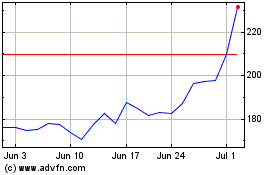Ford Aims to Cut Global Workforce Roughly 10% -- Update
May 15 2017 - 10:08PM
Dow Jones News
By Christina Rogers
Ford Motor Co. is planning substantial cuts to its global
workforce amid Chief Executive Officer Mark Fields drive to boost
profits and address the auto maker's sliding stock price, according
to people briefed on the plan.
The move comes as Ford targets $3 billion in cost cuts for 2017,
a plan aimed at improving profitability in 2018 even as U.S. auto
sales plateau. Ford's share price has suffered during Mr. Fields's
three-year tenure, and the company's market value has slipped far
behind Tesla Inc. and General Motors Co.
The job cuts, expected to be outlined as early as this week,
largely target salaried employees and aim to reduce the global head
count by an equivalent of about 10%, these people said. It is
unclear if the plan includes cuts to the hourly workforce at Ford's
U.S. factories and plants that are abroad.
"We remain focused on the three strategic priorities that will
create value and drive profitable growth, which include fortifying
the profit pillars in our core business, transforming traditionally
underperforming areas of our core business and investing
aggressively, but prudently, in emerging opportunities," Ford said
in a statement.
"Reducing costs and becoming as lean and efficient as possible
also remain part of that work. We have not announced any new people
efficiency actions, nor do we comment on speculation," the company
said.
Ford has 200,000 employees globally, half of which work in North
America. Deep cuts in the U.S. could trigger political backlash due
to the role the auto industry played during the campaign and early
tenure of President Donald Trump.
Mr. Trump pressured Ford to pull back on Mexico production and
invest in U.S. factories. Ford committed to scrap a Mexican factory
that had been under construction until earlier this year. The
company will add 700 jobs in Michigan with money saved in
Mexico.
Mr. Fields last week faced heightened scrutiny from board
members and investors who have long complained about Ford's
sluggish stock performance in an era of record profitability.
Ford has launched into a series of new technology investments
under Mr. Fields, including a $4.5 billion electric-vehicle program
and an aggressive autonomous-car project. While both programs could
contribute to Ford's longer-term prospects, the spending erodes
profit margins at a time when sales of lucrative pickups and sport
utilities remain strong.
The auto maker's stock price has fallen nearly 40% since Mr.
Fields became CEO in mid-2014. Shares have fallen even as the
broader U.S. auto market has grown for seven straight years. Now,
as volumes stabilize, executives are turning to downsizing moves
that were necessary a decade ago.
While Mr. Fields worked to ease political tensions, he hasn't
been able to answer investor concerns about Ford's ability to
weather a downturn or find new sources of revenue. The Dearborn,
Mich., auto maker has booked substantial profits in recent years,
including delivering two consecutive years of record earnings, but
its market value sunk below electric-car maker Tesla Inc. earlier
this year.
Now, Ford is guiding to leaner profits in 2017 and has flagged
slowing sales in the U.S. and China -- two of the world's largest
auto markets.
Ford has been steadily expanding both its salaried and unionized
workforce since the financial crisis. While many employees have
been added to support higher volumes and expansion in global
markets, Mr. Fields has also been hiring to support new technology
ventures that fall outside of the company's core business of
building and selling cars.
These new projects include a unit called Ford Smart Mobility
LLC, and an expanding presence in Silicon Valley where several tech
giants are rushing forward with car-sharing ventures, driverless
cars and other future mobility experiments. Ford in February,
announced it would acquire artificial-intelligence startup Argo AI
with plans to invest $1 billion over the next five years to expand
the firm.
Write to Christina Rogers at christina.rogers@wsj.com
(END) Dow Jones Newswires
May 15, 2017 21:53 ET (01:53 GMT)
Copyright (c) 2017 Dow Jones & Company, Inc.
Tesla (NASDAQ:TSLA)
Historical Stock Chart
From Mar 2024 to Apr 2024

Tesla (NASDAQ:TSLA)
Historical Stock Chart
From Apr 2023 to Apr 2024
